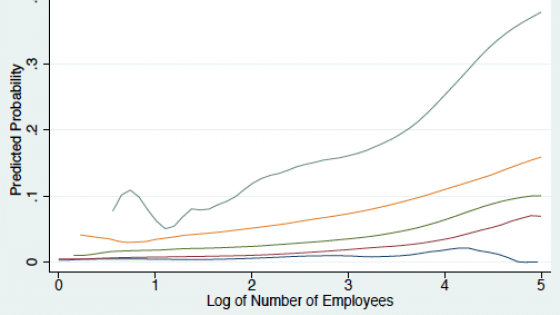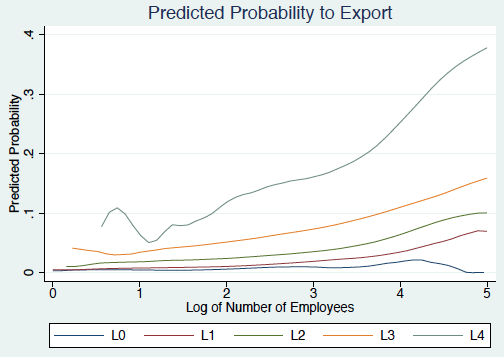Why do so few firms become successful in global markets? Are there some common characteristics among successful firms? Economists have tackled these questions from several angles, recently focusing on the internal organisation of firms. The idea is simple. Besides determining how many workers it employs, a firm’s key organisational decision is about the skill-knowledge-experience mix of its workers, and the division of their labour.
A recent literature has shown that a common characteristic of successful firms appears to be a deliberate and active management of their internal structure (Caliendo et al. 2012). As they expand, thriving firms add more specialised employees in a well-organised hierarchical structure. In a recent study, we analyse whether policies can prompt and support firm reorganisations (Cruz et al. 2016). The evidence on the effectivity of programmes aiming at improving firms’ internal structures is still limited but seems positive. This result is quite important, especially in light of the current debate of a global trade slowdown (Hoekman, 2015). We analyse if a programme focused on enhancing the competitiveness of small and medium enterprises (SMEs) in Brazil induces firms to reorganise knowledge by adding layers of more specialised skills and competencies to their workforces. We find that:
- Firms participating in the programme are more likely to reorganise knowledge by adding a new layer of workers with more specialised skills and competencies to their structure;
- The effect of the programme is stronger for firms starting off with the simplest organisational structure;
- The reorganisation of treated firms is associated with an expansion of the initially lower layers of knowledge and a rise in the wage gap within the firm;
- Firms with a higher number layers of knowledge, controlling for numbers of employees, are more likely to be exporters.
Hierarchies of knowledge: What does this means for firms' performance?
Firms with the same number of employees can have quite different internal structures. Usually firms organise knowledge following hierarchical structures, in which higher layers are smaller and occupied by more specialised workers dealing with non-routine problems. Organising internal knowledge is crucial for success. Differences in how firms organise and manage their labour (and other) inputs explain important differences in performance between firms, as well as, between countries (Bloom and Van Reenen 2007, 2010, Bloom et al. 2010, 2013, Caliendo et. al. 2015a).
Following the conceptual framework of Garicano (2000) and Caliendo and Rossi-Hansberg (2012), we identify different layers of employees within firms. Lower layers include production workers dealing with routine production problems, and upper layers include employees with more specialised knowledge and managers attending exceptional problems. In this framework shifting to a more complex structure, i.e. adding a layer, brings the advantage of specialisation and a reduction of marginal costs. When a layer of knowledge is added, firms can expand and production costs can go down because production workers can focus on routine tasks that can be performed by additional low-wage workers (or even automated), and just a few more knowledgeable (and high wage) workers are added in the new layers. Increasing the number of layers does not necessarily mean increasing the number of manager positions, but rather incorporating workers with different levels of competency and specialised knowledge in solving different problems. Thus, the layer of knowledge captures only one type of reorganisation, but one that matters for performance (Caliendo et. al. 2015b).
The data for Brazil show that similarly sized firms have very different internal structures. Almost the same share (5%) of medium-sized firms – those with 19–20 employees – have either a very simple structure with no layers or a fairly complex one with four knowledge-based layers of employees (see Figure 1). Note, however, that a more complex internal organisation is associated with an increased likelihood of being an exporter, as shown in Figure 2. Among firms with 20 employees, those with three layers are about 2.9 times more likely to be engaged in exporting activities than those with one layer of hierarchy of knowledge.
Figure 1. Firms with similar number of employees may have different organisation of layers
Figure 2. Firms with more layers, controlling for the number of employees, are more likely to be exporters
Note: (1) Refers to the distribution of the number of employees for firms with different number of layers of knowledge. (2) Refers to the likelihood of being an exporter conditional on number of employees for firms with different number of layers of knowledge. Source: Cruz et al. 2016.
The Peiex programme
The Peiex programme was launched in late 2008 to provide consulting services to medium and small firms by the Brazilian Export Promotion Agency (Apex-Brasil). The programme – which focuses on improving the organisation of firms – aims at boosting competitiveness and demonstrating the potential of exporting for micro, small and medium-sized enterprises. It provides capacity-building and management coaching, offering consulting services in partnership with universities and local institutions in fields such as marketing, human resources management, finance, product design, and trade (Borges 2010). The initiative was released as a supplementary assistance to firms interested in taking part of export promotion services but not yet fully ready to compete in global markets, and therefore could be considered a pre-export preparation programme.
Does Peiex assistance impact the organisation of the firm?
Using an instrumental variable approach to identify the impact of the programme, we find evidence that Peiex has an effect on firms' active management of their internal organisation. The programme increases the propensity to add workers with level of knowledge not previously available in their structure. On average, this propensity increases by almost 20%.
We also report that the likelihood of adding a layer increases with Peiex's support for smaller firms – those that had between zero and one layer – which were non-exporting in earlier years (2007 and 2008). However, we find no significant effect for firms that had between two and three layers of hierarchy of knowledge and were non-exporting in earlier years.
In addition, we find that Peiex is associated with an increasing wage gap within firms. Specialised knowledge gets concentrated in the new upper layer where workers receive higher wages; at the same time, initially lower layers expand.
Our findings also indicate that adding layers of knowledge is an organisational change that is correlated with outcomes relevant to firms’ performance. Controlling for numbers of employees, firms with more layers of knowledge are more likely to be exporters.
Conclusion
Improving the way firms organise knowledge and manage production may shed new light on policies oriented to improve productivity, which lies at the heart of competitiveness. Providing coaching and consulting on management and production practices is an important additional tool to be considered by policymakers in the efforts to boost productivity. Rather than yielding to more protectionist interventions, policymakers should seriously consider exports supporting programs focused on enhancing firms’ competitiveness.
References
Bloom, N and J Van Reenen (2007), “Measuring and explaining management practices across firms and countries” The Quarterly Journal of Economics 122 (4), 1351-1408.
Bloom, N and J Van Reenen (2010), "Why do management practices differ across firms and countries?", The Journal of Economic Perspectives, 203-224.
Bloom, N, A Mahajan, D McKenzie, and J Roberts (2010) “Why do firms in developing countries have low productivity?”, American Economic Review: Papers & Proceedings 100(2), 619-623.
Bloom, N, B Eifert, A Mahajan, D. McKenzie, and J Roberts (2013), “Does management matter? Evidence from India”, Quarterly Journal of Economics 128(1)
Borges, M (2010), Apex-Brasil presentation on Peiex program, presented at the 2010 TPO Network Conference and Awards, International Trade Center. Available online at www.intracen.org.
Caliendo, L and E Rossi-Hansberg (2012), “The impact of trade on organization and productivity”, The Quarterly Journal of Economics 127(3), 1393-1467.
Caliendo, L, F Monte and E Rossi-Hansberg (2012), “Firms reorganise to grow (by hiring workers that know and earn less)”, VoxEU.org, 31 August.
Caliendo, L, G Mion, L Opromolla, and E Rossi-Hansberg (2015a), “Productivity and Organisation in Portuguese Firms,” CEPR Discussion Paper No. 10993.
Caliendo, L, F Monte, and E Rossi-Hansberg (2015b), "The anatomy of French production hierarchies", Journal of Political Economy 123(4).
Cruz, M, M Bussolo and L Iacovone (2016), "Organizing Knowledge to Compete: Impacts of capacity building programs on firm organization," Policy Research Working Paper Series 7640, The World Bank.
Garicano, L (2000), “Hierarchies and the organization of knowledge in production”, Journal of Political Economy 108 (5), 874-904.
Hoekman, B (2015), The Global Trade Slowdown: A New Normal?, CEPR Press.








